Decision
There were three scripts on the table, two comedies and a
drama. The Colchester Film Makers Club had produced a
comedy last year and the year before that so maybe it was time
for something new?
It’s not what you film; it’s how you film it. We’re talking
style not hardware.
- Once the audience recognizes an actor on screen the
suspension of disbelief is broken. “That’s Bill up
on screen. He always plays the baddie!”
- So the decision was to remove the identities of all the
characters. There would be no emotions normally
expressed with facial expressions or voice acting. It
was to be similar to a TV news report – just the facts.
- No taking sides and judging who was in the right and who was
in the wrong. Remove the emotions, just show the facts.
- It was a bold idea but the film team were happy to run with
it, especially as they didn’t have to learn lines!
- Film making is about controlling the audience. Show
what you want them to see in order to tell the story and use
sound appropriately. By removing facial identities it
meant anyone could play the parts.
The director (Henryk Jachimczyk) played the
husband, while Paul Desmond, one of the
cameramen, put on the trench coat and became the
detective. The lighting assistant put on a dress and was
arrested! (Joke!)
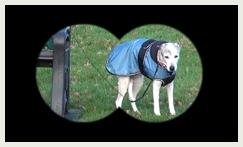 Crew Crew
Organizing the crew to meet at the same time and place is
always difficult, so the team was split in two and convened at
different locations on suitable days. There were three
individual females that played the wife and three crew members
played the detective at three different locations.
There was only one dog, however, who was played by the dog.
Edit
The decision to split the screen up with different views was to
imitate TV news programs. Each channel covers a particular
story but would have different camera angles of the same
subject.
Our film introduced each shot in a particular order meaning the
viewer was more active and hopefully wouldn’t be bored.
However the scene in the sitting room, where husband and wife
are seated in the same shot, was visually split to suggest a
particular relationship.
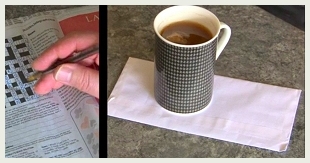 Composition had to be considered. With
three, maybe four shots on screen at the same time this dictated
images had to be simple and easy to read, especially as they
would be in smaller frames. Composition had to be considered. With
three, maybe four shots on screen at the same time this dictated
images had to be simple and easy to read, especially as they
would be in smaller frames.
The scene where the husband is preoccupied with a crossword
puzzle was originally much longer. The idea was to stretch
out the tension as the viewers knew the envelope contained a
ransom note. But after a test screening at the Colchester
Film Makers Club, members’ comments suggested shortening the
sequence.
Sound
There was purposely no music because that would cue
emotions. Instead, sounds from the scenes were used in a
rhythmic way. The title introduction starts with a paper
tear followed by the repeated snipping of paper followed by the
sound of an envelope being sealed.
In the detective’s office the background beat was the
repetitive sound of paper being torn from the pad he was writing
on.
As the husband and wife waited for the detective to return the
ticking of a clock beat out the seconds.
Most of the film had to be dubbed. We had parked the car
next to a noisy children’s nursery.
Filming
The whole film was story-boarded to assist the director and
cameramen but there were some blank areas for creativity.
During the course of the production opportunities arose.
The two birds in the tree came about by the director opening the
front door one morning and spotting the shot across the road.
The close-up shot of the magpie pecking was supplied by keen
bird watcher Brian Pearce.
Colour
Natural light was used outside. We were lucky the sun
shone brightly on the day. And small spotlights helped
indoors.
There was some help in post-production with brightening up the
dark shots and increasing the contrast but no atmospheric
colouring. This would suggest mood and therefore emotions.
The only true colour consideration was for the character of the
wife. She was introduced in a white dressing gown, then
wore a pink sweater and finally wore bright red at the end.
Subconsciously suggesting she was innocent at first and became a
scarlet woman. Did anyone notice?
Oops!
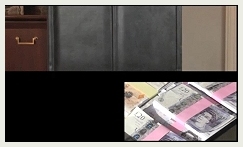 There were no production mishaps but we were
told to move our car by the Children’s Nursery Teacher. There were no production mishaps but we were
told to move our car by the Children’s Nursery Teacher.
To the amusement of the crew the message on the ransom note
read: “Do not show this side to the camera.”
We found the park rubbish bin was too small and the briefcase
had to perch on top at a peculiar angle. However, creating
the case of money was a problem. The printer refused to
scan in real bank notes. A photograph was downloaded
instead and printed several times to top the bundles.
Did anyone think that was a lot of money for a
crossbreed dog?
- by Henryk Jachimczyk (who wrote, directed and edited the
award winning entry by Colchester Film Makers Club)
Watch the film online
Click here: RANSOM
NOTE
|

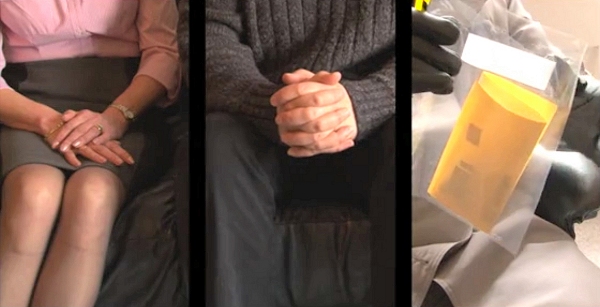

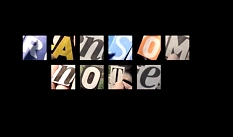
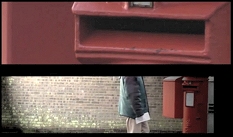
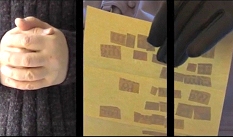
 Crew
Crew Composition had to be considered. With
three, maybe four shots on screen at the same time this dictated
images had to be simple and easy to read, especially as they
would be in smaller frames.
Composition had to be considered. With
three, maybe four shots on screen at the same time this dictated
images had to be simple and easy to read, especially as they
would be in smaller frames. There were no production mishaps but we were
told to move our car by the Children’s Nursery Teacher.
There were no production mishaps but we were
told to move our car by the Children’s Nursery Teacher.